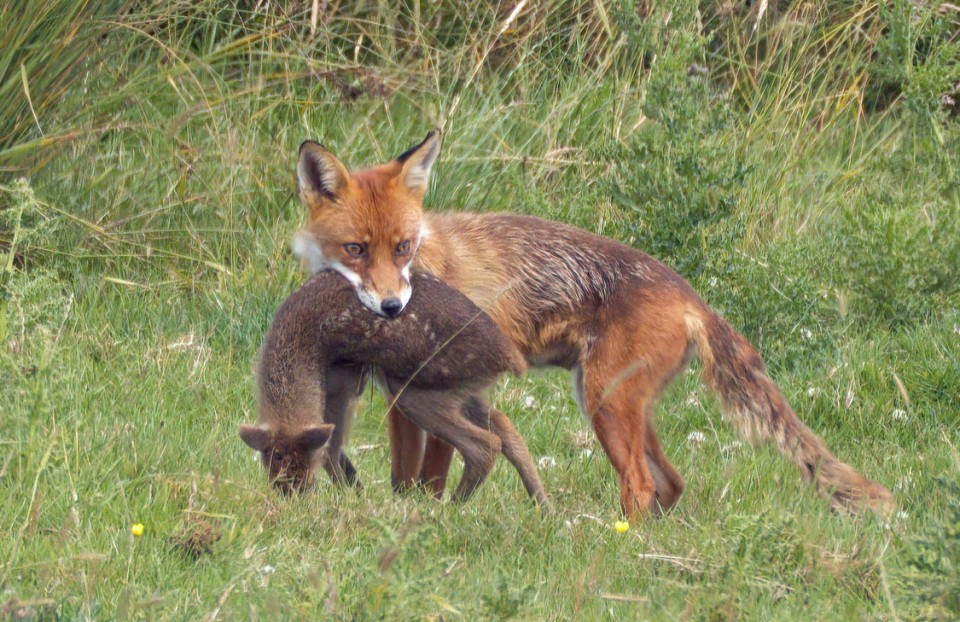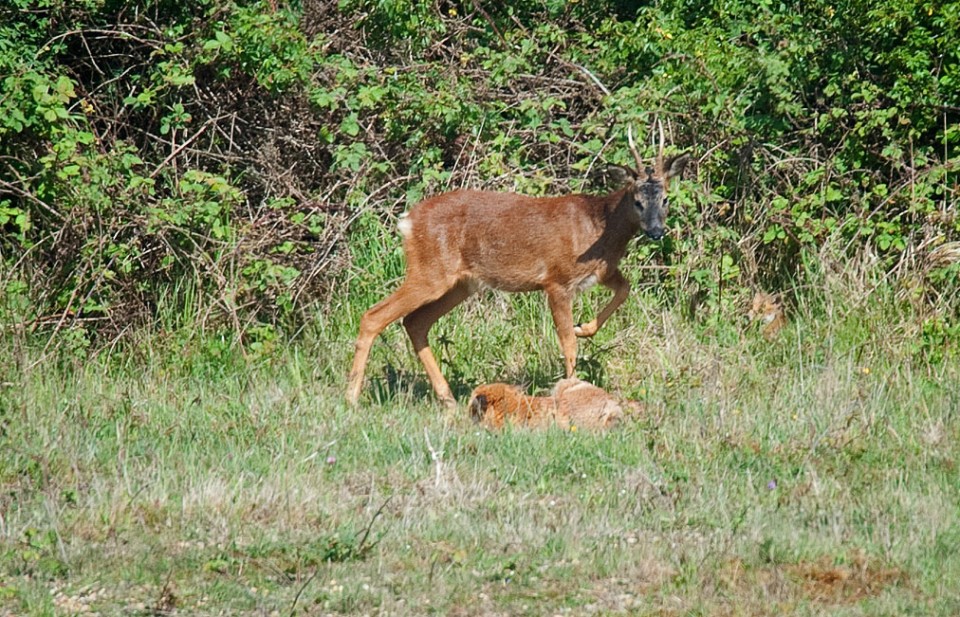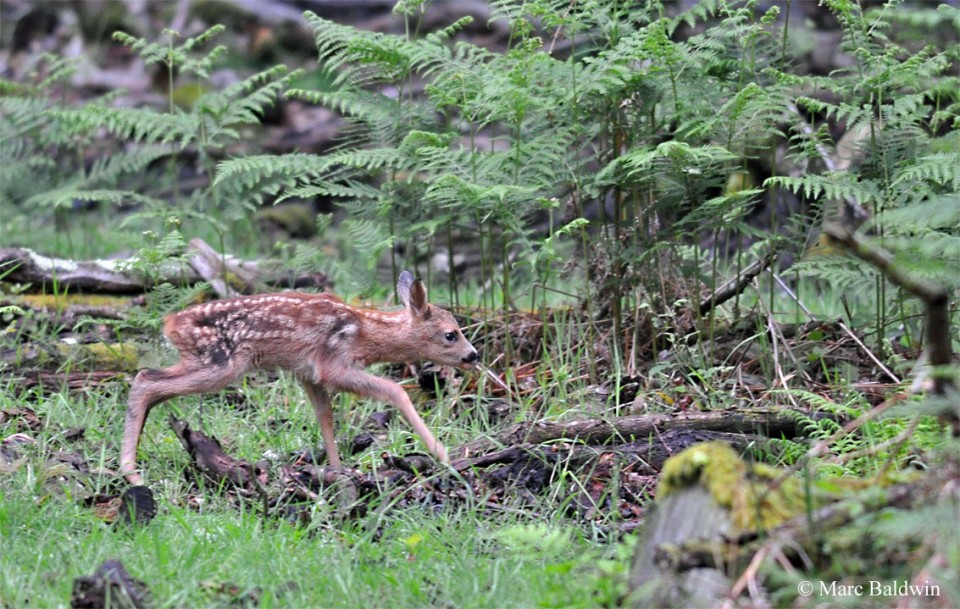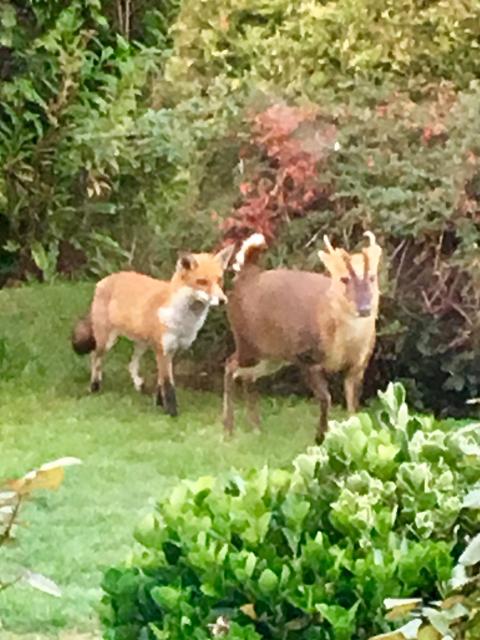Red Fox Interaction with Other Species - Deer
Tackling adults of any of the six species of deer found wild in the UK is likely beyond the capability of a fox, particularly given that they are solitary hunters, but venison does turn up in dietary analyses from time to time. Most of this invariably represents meat scavenged from carcasses that the fox has found; in some northern habitats, these carcasses can be an important component of a fox's winter diet. In some cases, however, the remains may be of yearling deer -- called a calf, fawn, or kid, depending upon the species. How significant foxes are as a predator of young deer is largely unknown. Foxes are thought to be significant predators of Reeves' muntjac (Muntiacus reevesi) (see: The Fox as an Ally) and Chinese water deer (Hydropotes inermis) fawns, but it's their relationship with Roe deer (Capreolus capreolus) for which we have the most data.

In 1972, Helmuth Strandgaard presented data on a population of Roe at Kalø in Denmark that pointed to kid survival dropping by 60% when fox control in the area ceased. Similarly, during a two-year study of roe mortality in Sweden, Ronny Aanes and Reidar Andersen found that fox predation was the biggest cause of kid death. More recently, in 2004, Swedish University of Agricultural Sciences biologist Anders Jarnemo completed his doctoral thesis on neonatal mortality in Roe deer -- i.e., how many, and by what means, new-born roe kids died. Using data collected in two areas of central Sweden between 1986 and 2003, Jarnemo found that about half of kids died during the summer months and foxes were responsible for the majority (88%). The kids were most vulnerable to foxes during their first week of life, the threat decreasing with increasing age. Most (85%) kids were taken before they reached a month old, with only 2% of those taken being older than 40 days.
In one of the areas, Jarnemo found that fox abundance was the only factor that had a significant impact on kid survival in any given year (i.e., more kids survived in years when fox abundance was low, such as during a serious outbreak of mange) and, in both areas, kids born early or late in the season were most at risk from fox predation. Jarnemo also found that does (females) were more likely to lose a kid left hiding in open habitats, where they were presumably more visible to foxes, although they were quite capable of chasing away a fox if they spotted it. Indeed, in his book The White Foxes of Gorfenletch, Northumberland naturalist Henry Tegner recounts watching a vixen kill a roe deer kid before being driven off by its mother:
"When [the kid] was within five feet of the vixen she sprang for his throat. Like a terrier, the vixen shook the little roe to break his neck."

The kid's short cry brought the doe down the knoll at full charge and:
"Seeing the vixen, [the doe] went straight for her, her front hooves striking out at the fox like a pair of stabbing lances. Leaving the dead fawn where she had killed him, the yellow vixen beat a tactical retreat."
Tegner recalls that the doe stayed with her dead kid and its sibling until dusk, when she and her remaining kid moved off to feed. With the coming darkness, the vixen returned, collected the dead kid and carried it back to her cubs. I have included Tegner's account here because, although I suspect some of the story as told in his book is embellished with artistic licence, he was a well-respected naturalist and member of the British Deer Society. As such, I believe his observation about how a mother deer would attack a fox to be broadly accurate. It certainly ties in with other accounts I have come across.

So, overall, foxes can have a significant impact on roe deer kid survival, although it's important to consider the habitat, birthing period, mother and kid behaviour, and, presumably, the availability of other food sources. One final note on the subject of roe deer predation is that it may not be limited to the very young animals recorded by Jarnemo. In January 2024, I was sent a video from Germany showing a fox involved in a hard chase (both panting hard) with a roe kid, the latter estimated to have been around eight months old and 40-50% larger than the fox, for at least 30 seconds. The fox was able to catch and pin the kid by darting in front of it, causing the kid to stop short, allowing the fox to grab the neck and push forward to bring the deer to the ground. Unfortunately, as soon as the fox had pinned the kid it was shot dead, so we do not know whether the fox would've been able to complete the kill. There are also a couple of videos on YouTube that appear to show foxes tackling either adult roe does (females) or very well-grown kids, including one of a fox repeatedly snapping at the legs of a large kid before chasing it around a field and into long vegetation where much screaming was hear that might imply the deer was caught. Likewise, in Finding the Fox, Andreas Tjernshaugen noted: "I once saw a recording from a wildlife camera in a snowy part of Norway that showed a roe deer running for its life along a forest trail on a winter night, with a fox in hot pursuit". We have no data on how often adult or nearly-full-grown kids are tackled or killed by foxes, but it appears to be rare.
One final point on the interaction between deer and foxes: not all encounters are aggressive or predatory. I have seen foxes cross through fields of deer with each ignoring the other and, in the New Forest, have watched a fox pouncing on rodents in a field as red and roe deer grazed, their young hidden nearby. There are also interesting anecdotal reports of apparent play behaviour between muntjac and foxes. (I remain sceptical, but the subject is included here for completeness.) In May 2008, for example, a gentleman posted on a wildlife Internet forum describing footage that he had been sent by a friend apparently showing a fox and Reeves' muntjac deer in the garden of their London home. He explained:

"[the footage] is of an adult fox and a muntjac deer playing wildly together in the garden. They take it in turns to chase each other around the various shrubs etc. The fox looks the most enthusiastic of the two, cavorting and leaping around like a big kitten with those characteristic 'mouse jumps'."
One forum member responded to say:
"It's been seen before at Thames Valley Park by their night security officers, but so rarely you'd have to be very, very lucky to catch it on film."
A quick Internet search revealed that Dave Coward has some clips of a muntjac and fox interacting in his garden on his YouTube channel, but I would caution against interpreting this as anything more than curiosity on the part of both species. Additionally, in August 2019, Phil Ellis sent me a video of a fox and muntjac seemingly playing in his garden and, during October of the following year, Jackie Wagner sent me some mobile phone footage of a fox and muntjac interacting in a field. In Jackie's video, the muntjac appeared to be moving through the field as the fox circled it and charging back and forth in what could be described as a playful manner. Subsequently, in May 2021, Lorna King contacted me to describe a curious encounter between a fox and small group of deer that was acted out in the field across from her house. A pair of foxes were regularly seen in the field at the same time of day as the deer, typically each ignored the other. On this occasion, however, a hunting fox stopped pouncing and, Lorna told me:
"... the fox then approached the deer, one of which stopped to stare, the others continued browsing. The fox then started to run in, run away, drop down in the grass like a collie, roll around in the grass, jump up and down, and repeated. The deer were observant but did not move. This continued for about 15 minutes until one of the deer turned, at which point the fox raced round and round the herd (still feeding), dropped down and repeated. The deer eventually started chasing the fox, which just carried on. I got the distinct impression the fox was playing, and the deer got irritated but were not threatened - they did not move away but remained either sitting or feeding. I watched this for about 40 minutes until it got dark."

In addition to play-like behaviour, I have seen and received several reports from the UK of foxes and muntjac apparently travelling together. During October 2018, Lisa Collischon posted on the BBC Autumnwatch Facebook page about a fox and muntjac together in her garden in Essex:
"My son was watching them - they definitely arrived together. When I was watching them they were eating from the same bush side by side and then walked around for a good few minutes together before running off - the Muntjac first very closely followed by the fox! They definitely seemed like they were good buddies!"
Natasha Scott came across a muntjac and fox seemingly hanging out together while she was walking her dogs in Norfolk. A couple of days later Natasha saw them again in roughly the same area and told me that she has often wondered what was going on as they appeared to be at ease with each other (i.e., no obvious predatory behaviour from the fox and no signs of distress from the muntjac). In neighbouring Suffolk, Alan Baldry captured a pair apparently travelling together on the same trail camera over several nights in January 2023. More recently, during June 2024, Raymond Shaw photographed a fox and muntjac doe crossing a railway line in Huntingdon, Cambridgeshire. According to Raymond "they came out of the trees together, stood side by side for about a minute, then both crossed 2 tracks before parting ways". One of the comments when Raymond posted the photos in a Facebook group stated that the fox would've been waiting for the doe to give birth so the fox could take the fawn. This is an interesting idea, although the doe didn't look obviously pregnant from the photos (although she may have been in the early stages) and this does not account for all accounts, some of which included foxes with bucks.
Outside of Britain, in April 2022, Rhett Acosta at the University of California, Santa Cruz contacted me to describe an apparent association between a deer and red fox during early July in Santa Cruz:
"In the summer of 2021 in California I saw a deer and a fox sprint together through a field. Not in chase, the two followed a trail and where it narrowed the deer slowed and waited for the fox to catch up. They ran side by side. At first I spotted them together; in a patch of grass close to each other. Once they became aware of my presence they fled. I was shocked to watch how they ran. The two running away looked like a Disney film from the 30s. It was clear that they had some sort of bond."
I would be interested to hear from other readers who have observed deer and foxes travelling together, and particularly foxes travelling with different species of deer. It is perhaps notable that the half a dozen or so reports of fox-deer associations in the UK have all involved Reeves' muntjac.